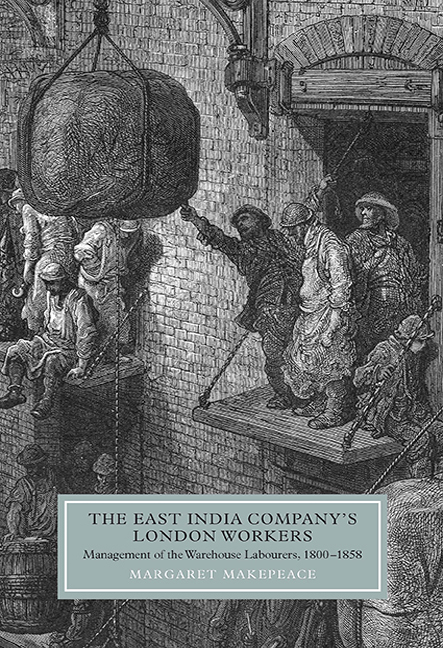Book contents
- Frontmatter
- Contents
- Figures and tables
- Dedication
- Acknowledgements
- Abbreviations
- 1 Introduction
- 2 The East India Company Warehouses
- 3 The Warehouse Labourers
- 4 Management Strategies: Incentives, Rewards and Benevolence
- 5 Management Strategies: Systems of Internal Control
- 6 The Royal East India Volunteers: The ‘Union of Civil and Military Dependence’
- 7 The Relationship Between the East India Company and its London Warehouse Labourers
- 8 The Warehouse Closures
- 9 Management of the Warehouse Labourers and Pensioners 1838–1858
- Conclusion: ‘Good Masters to the Lower Class of Their Dependents’
- Bibliography
- Index
3 - The Warehouse Labourers
Published online by Cambridge University Press: 13 April 2017
- Frontmatter
- Contents
- Figures and tables
- Dedication
- Acknowledgements
- Abbreviations
- 1 Introduction
- 2 The East India Company Warehouses
- 3 The Warehouse Labourers
- 4 Management Strategies: Incentives, Rewards and Benevolence
- 5 Management Strategies: Systems of Internal Control
- 6 The Royal East India Volunteers: The ‘Union of Civil and Military Dependence’
- 7 The Relationship Between the East India Company and its London Warehouse Labourers
- 8 The Warehouse Closures
- 9 Management of the Warehouse Labourers and Pensioners 1838–1858
- Conclusion: ‘Good Masters to the Lower Class of Their Dependents’
- Bibliography
- Index
Summary
at the peak of its commercial activities in the early nineteenth century, the East India Company employed more than 3000 labourers in its London warehouses, the largest single body of civilian manual workers in London at that time. This was a marked increase from the establishment maintained in 1785 when the total permanent workforce in the warehouses amounted to 1393, of whom 1252 were labourers and seventy were commodores and writers. By 1793, the number of daily paid workers, comprising the deputy assistant elders, commodores, writers and labourers, had increased to 1800, and in May 1798, with more warehouses in use and the legal obligation to keep a stock of at least one year's worth of domestic tea consumption, there were 2784 persons employed in the warehouses. By May 1817, the full complement of warehouse staff had risen to seven keepers; four assistant keepers; fifty clerks; two extra clerks; eighteen elders; thirty-seven assistant elders; thirty deputy assistant elders; 125 writers; and 3123 labourers, commodores, gatekeepers and messengers; together with a staff of 123 at East India Wharf. By 1827, the number of labourers had increased to 3320, but it then began to fall once a programme of retrenchment began in 1828: in April 1832 there were 2415 warehouse men including twenty-four messengers and twenty-eight boys serving as drummers in the Royal East India Volunteers.
The number of new Company servants recruited to maintain the warehouse establishment varied greatly from year to year depending on the state of trade and on how many employees had been lost through death, retirement, resignation or dismissal. Labourer appointments were made on an individual basis, contrasting with the way in which the Company's Dutch counterpart, the Verenigde Oostindische Compagnie, operated in Amsterdam. All Amsterdam merchants were obliged by local government regulations to have their goods transported in the city by co-operatives of weigh-house porters, known as the vemen, and the VOC often chose to use the same groups of men for warehouse storage tasks.
- Type
- Chapter
- Information
- The East India Company's London WorkersManagement of the Warehouse Labourers, 1800–1858, pp. 40 - 66Publisher: Boydell & BrewerPrint publication year: 2010



